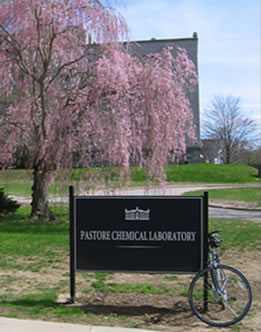
March 31, 2007
The University of Rhode Island Department of Chemistry has chosen MeasureNet to equip five of the Department's General Chemistry laboratories. MeasureNet capabilities selected by URI faculty include probeware for temperature, pressure, pH, and voltage, as well as MeasureNet's advanced multi-function colorimeter.
The University of Rhode Island was chartered as the state's agricultural school in 1888. The Oliver Watson farm was purchased as a site for the school, and the old farmhouse, now restored, still stands on the campus. The school became the Rhode Island College of Agriculture and Mechanic Arts in 1892, and the first class of 17 members was graduated two years later. The University is currently home to over 15,300 students with nearly 63% originating from within the state.
In response to a high level of student interest in forensic science and URI's growing international expertise in this area, students may now choose a new bachelor of science in chemistry and forensic chemistry. The new major is, at its core, the traditional chemistry curriculum with alternative courses that address the use of chemistry in forensics.
"We are delighted to have the University of Rhode Island join the MeasureNet Community," says MeasureNet President Robert Voorhees. "It has a growing enrollment and boasts a number of new innovative programs. Rhode Island's purchase again affirms MeasureNet's suitability for departments not wanting the maintenance and replacement responsibility for large numbers of PCs, yet want high-resolution acquisition tools that are easy to use and prepare students for future workplaces and research environments."
MeasureNet Technology Ltd. manufactures patented, network-based data acquisition interfaces for science teaching laboratories. It is a spin-off of the University of Cincinnati's Department of Chemistry and is headquartered in Cincinnati, Ohio. Measurenet's award-winning, PC-reducing design helps reduce laboratory maintenance and operational costs while giving students access to high quality shared UV-vis spectroscopy, gas chromatograph and HPLC connectivity, and an array of innovative probeware. Its acclaimed intuitive design provides improved transparency to enable better science-focused learning. Winner of the Ohio Governor's Award For Excellence in Energy Efficiency, MeasureNet networks are found in universities, community colleges, high schools, and vocational training centers across the United States and around the world.
For more information contact:
Len Weibel
Director of Business Development
tel. toll-free: 866-396-6765
lenweibel@measurenet-tech.com

> URI Department of Chemistry
A Journal of Chemical Education article titled Managing Laboratory Data Using Cloud Computing as an Organizational Tool by Jacqueline Bennett and Harry E. Pence (J. Chem. Educ. June 2011:Vol. 88 no. 8) brings to light the the key role cloud computing will play in laboratory instruction.
The authors summarized the benefits of the cloud from a research and educational perspective nicely... "Cloud computing, where both software and computer files reside online, offers a solution to this data-management problem and allows researchers to coordinate their efforts just as easily whether they are working in the same laboratory or laboratories halfway around the world ".
MeasureNet Technology has been supplying chemistry lab instructors with cloud based tools for data-management, data security and Collaborative/Cooperative Learning solutions for many years. MeasureNet's Laboratory Electronic Measurement and Data Collection Technology is used in university chemistry labs by students to measure and collect data sets in the lab, store and share on the cloud and analyze these data sets from anywhere via the cloud. MeasureNet's patented unique Network design takes cloud computing to the next level by connecting students to the lab TA or instructor while they are are conducting the experiments. Using MeasureNet's real-time monitoring capablities, TA's in the lab can monitor student experiments to make sure they are conducting the experiments properly. Instructors or collaborators can also monitor the live data collection with their computers from any remote location via the internet.
The MeasureNet system is a product of research conducted at the University of Cincinnati by Robert Voorhees, Estel Sprague and Paul McKenzie.
For more information contact:
Robert Voorhees
President & Founder
Ph: 866.396.6765
voorhees@measurenet-tech.com
The secret is out! A recent article titled Method is more vital than teacher by AP Science Writer, Seth Borenstein, May 13, 2011, summarized a paper published in the journal Science. The title of the paper Improved Learning in a Large-Enrollment Physics Class by Louis Deslauriers, Ellen Schelew and Carl Wieman (Science 13 May 2011:Vol. 332 no. 6031 pp. 862-864).
The research concluded "students learned a lot more from teaching assistants using interactive tools than they did from a veteran professor giving a traditional lecture".
Lecturers are learning what science lab instructors have know for decades, "students learn best by doing".
MeasureNet Technology has been helping chemistry lab instructors with this goal for over 13 years. MeasureNet's Laboratory Electronic Measurement and Data Collection Technology is used in university chemistry labs by students to measure, store and analyze data they collect doing their lab experiments. This hands on real-time interactive activity helps students reinforce and apply what they have learned in lecture. MeasureNet's patented unique Network design takes this interactive learning to the next level by connecting students to the lab TA or instructor while they are are conducting the experiments all in real-time. Using MeasureNet's real-time monitoring capablities TA's can monitor student experiments to make sure they are conducting the experiments properly. This allows the TA to intervene if they see a problem to make sure the student leaves the lab with good data. The validated data is then up-loaded to MeasureNet's cloud based data storage site for later graphical analysis which will be included in the students lab report.
The MeasureNet system is a product of research conducted at the University of Cincinnati by Robert Voorhees, Estel Sprague and Paul McKenzie.
For more information contact:
Robert Voorhees
President & Founder
Ph: 866.396.6765
voorhees@measurenet-tech.com
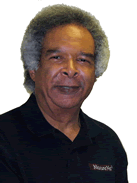
Efficient Use of a Shared MeasureNet Spectrometer
MeasureNet Spectrum Quarterly; July, 2006
I was talking with Michael Kurutz at the spring ACS conference, and he mentioned that he was not sure that all of our users are aware of how to minimize queues from forming when using the MeasureNet spectrometer in their laboratories. We decided that this would be a useful topic to discuss in this column. Since I am not personally involved in the teaching labs, I wanted someone with experience to describe how they use the MeasureNet shared spectrometer in their lab. So, I asked colleague and friend Professor Estel Sprague (of the Department of Chemistry at the University of Cincinnati) if he would tell us how he avoids student pileups at the spectrometer in his labs. Below is what Estel had to say...
Spectroscopy? – Get In Line!
That is exactly what we don’t want to hear when we use spectroscopy in the lab. We want our students to be productively engaged, not wasting their time standing in line waiting for the spectrometer to be free. The MeasureNet networked spectrometer was carefully designed to hold such queuing-up for use to a minimum. The result is a radical departure from the traditional approach to spectroscopic measurements in the teaching lab.
Imagine yourself using a typical stand-alone spectrometer, probably attached to a PC. You first prepare the device to record a spectrum, then make the actual measurements, and finally examine the results, probably saving and/or printing them. Throughout this process, you are monopolizing the spectrometer, hence, it cannot be used by anyone else. The approach used for the MeasureNet networked spectrometer involves separating out the actual data collection step from everything else. Setting up prior to measurement and subsequent data examination, saving, printing, etc., are carried out at individual workstations, NOT at the spectrometer. The students are at the spectrometer only long enough to make the actual measurements, typically a minute or so, and the spectrometer is then free for the next user. Used in this manor the MeasureNet network, with its controller, twelve workstations, and one networked spectrometer, effectively functions as anywhere from one to twelve independent, stand-alone spectrometers.
There are situations, however, in which queuing may be an issue unless you take steps as the instructor to prevent it. This is probably best illustrated by means of a real example: the determination of the pKa of an indicator from a series of absorption spectra. This experiment requires the preparation of seven buffer solutions, using the MeasureNet workstation as a pH meter. Each of these buffer solutions is used to prepare a solution containing an indicator, with the indicator concentration kept the same in all seven sample solutions. The absorption spectrum is recorded for each solution, and these are subsequently analyzed to yield the pKa value for the indicator.
If you or I carried out this experiment, we would naturally try to be efficient by first preparing all seven buffers, then preparing all seven solutions containing the indicator, and finally measuring all seven absorption spectra. If we were alone in the lab, this would be perfectly okay or even desirable. On the other hand, this is NOT the best way for our students to proceed, since no one would be using the spectrometer during the first two-thirds of the lab period, and everyone would be trying to use it near the end resulting in queues and difficulty getting the measurements finished in time. You, as the instructor, can avoid this by requiring the students to alter this natural procedure somewhat. After preparing the seven buffers, the students should take just one of them and prepare the first sample solution with indicator. The spectrum of this solution should be recorded, examined at the station, and saved, probably on MeasureNet’s remote data storage server. Only then should the second sample solution be prepared and have its spectrum recorded, and this sequence should be followed for the remaining samples. This modified procedure spreads out the use of the spectrometer over a much greater portion of the lab period and substantially reduces the likelihood and extent of queuing.
Spectroscopic methods occur throughout modern chemistry, so it is important to provide as much meaningful exposure as possible for our students. Using the MeasureNet networked spectrometer, with a little attention to procedural details, is an efficient and effective way to incorporate modern spectroscopic experiments into our teaching labs.
I want to thank Estel for taking time to share this information with us.
If you have a question about using any of the MeasureNet instrumentation, please contact me!
See you at the BCCE,

Elwood Brooks, Ph.D. is a MeasureNet Senior Applications Specialist and secretly moonlights as a Harley Tech. He can be reached at brooks@measurenet-tech.com
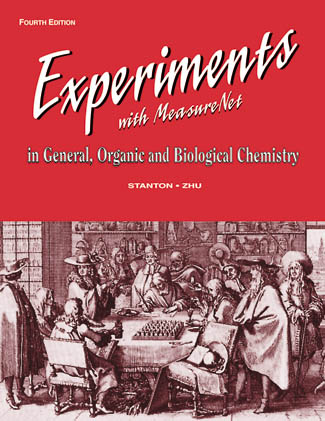
April 11, 2006
A newly revised chemistry lab manual featuring MeasureNet for non-science majors is being introduced by Contemporary Publishing. Experiments in General, Organic and Biological Chemistry, Featuring MeasureNet, authored by Bobby Stanton and Lin Zhu of the University of Georgia, will be available in mid March. It is a revision of their current laboratory manual to include extensive procedures for using MeasureNet's integrated, networked data collection system. The manual features innovative experiments, as well as collaborative, multi-component chemical analyses.
Incorporating MeasureNet into the laboratories affords students the opportunity to collect and manipulate scientific data in a manner realistically preparing them for future employment. The manual also contains self-directed experiments and can be used without MeasureNet.
Experiments that have integrated procedures for MeasureNet include “Specific Heat of a Metal,” “Emission Analysis of a Metal,” “Self-Directed Identity of an Unknown Metal,” “Concen-tration of Ascetic Acid in Vinegar,” “Self-Directed—Identity of an Unknown Metal,” “Concentration of Acetic Acid in Vinegar,” “Self-Directed—Quality Control for GlassEx,” “Amino Acids and Proteins,” and “Stoichiometry.” (View complete Table of Contents)
Instructors can request more information and order a review copy at Contemporary Publishing’s website (www.contemporarypublishing.com) or by telephoning (919) 851-8221.
MeasureNet Technology Ltd. manufactures patented, network-based data acquisition interfaces for science teaching laboratories. It is a spin-off of the University of Cincinnati's Department of Chemistry and is headquartered in Cincinnati, Ohio. Measurenet's award-winning, PC-reducing design helps reduce laboratory maintenance and operational costs while giving students access to high quality shared UV-vis spectroscopy and an array of innovative probeware. It's acclaimed intuitive design provides improved transparency to enable better science-focused, not technology-focused, learning. Winner of the Ohio Governor's Award For Excellence in Energy Efficiency, MeasureNet networks are found in universities, community colleges, high schools, and vocational training centers across the United States and around the world.
For more information contact:
Len Weibel
Director of Business Development
tel. toll-free: 866-396-6765
lenweibel@measurenet-tech.com

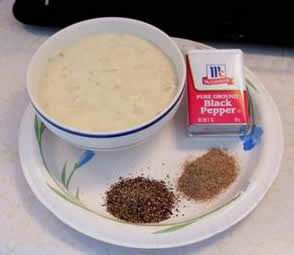
August 22, 2007
Dr. DeMento's Chemically Correct New England Clam ‘Chowda’
Ingredients:
1 tbsp butter (not margarine)
2 slices smoked bacon, diced
1 cup minced onions (Yellow or Vidalia, not Spanish or Red)
2 minced garlic cloves
3 tbsp diced celery
1 tbsp olive oil (Regular, not Extra Virgin)
1/2 tspn each herb:
Oregano, Marjoram, Thyme, Basil, Sage, Rosemary, Celery Salt
1 tbsp all-purpose flour
1 cup clam juice (use good quality w. sediment)
1 cup half-and-half
1 cup whole milk
1 tspn white pepper (freshly coarse ground)
1/2 tspn black pepper (freshly coarse ground)
1 cup Russet or Yukon Gold Potatoes; boiled & diced (2 medium)
8 oz. clams (fresh Littlenecks or 1 large can, Doxsee or Gortons)
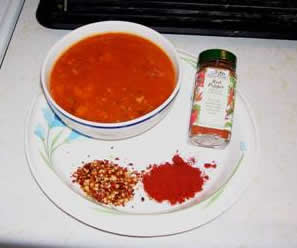
Dr. Jerry's NYC pH-Balanced Manhattan Clam Chowder
Ingredients:
4 tspn butter (1/4 cup, half-stick)
4 slices smoked bacon, diced
2 tbsp olive oil (Regular, not 'Extra Virgin')
1.5 cups large diced onions (Yellow or Vidalia, not Spanish or Red)
4 thin-sliced garlic cloves
0.5 cup diced celery
0.5 cup diced carrots
1 tbsp each herb: Oregano, Marjoram, Thyme, Celery Salt
1 cup clam juice (use good quality w. sediment)
2 whole bay leaves
1.5 cups Russet or Yukon Gold Potatoes; boiled & diced (3 medium)
28 oz. crushed tomatoes, Italian style (1 large can, 'peeled')
2 tbsp tomato paste
2 tbsp mild Paprika
2 cups / 16 oz. clams (fresh Littlenecks or 2 cans Doxsee or Gortons)
Dash of Tabasco / any pepper sauce in vinegar, to taste
> The Chemistry of Clam Chowders Power Point Presentation
> The Chemistry of Clam Chowders American Chemical Society Press Conference Photos
MeasureNet Technology Ltd. manufactures patented, network-based data acquisition interfaces for science teaching laboratories. It is a spin-off of the University of Cincinnati's Department of Chemistry and is headquartered in Cincinnati, Ohio. Measurenet's award-winning, PC-reducing design helps reduce laboratory maintenance and operational costs while giving students access to high quality shared UV-vis spectroscopy, gas chromatograph and HPLC connectivity, and an array of innovative probeware. Its acclaimed intuitive design provides improved transparency to enable better science-focused learning. Winner of the Ohio Governor's Award For Excellence in Energy Efficiency, MeasureNet networks are found in universities, community colleges, high schools, and vocational training centers across the United States and around the world.
For more information contact:
Len Weibel
Director of Business Development
tel. toll-free: 866-396-6765
lenweibel@measurenet-tech.com